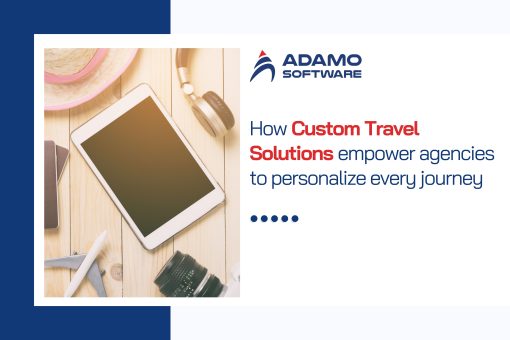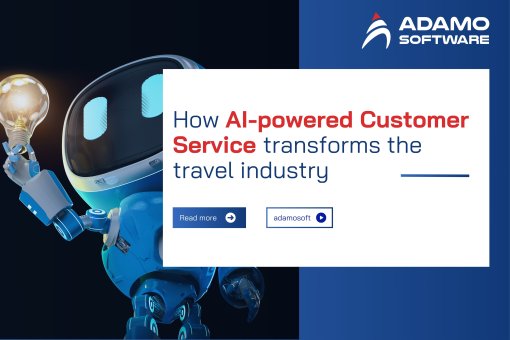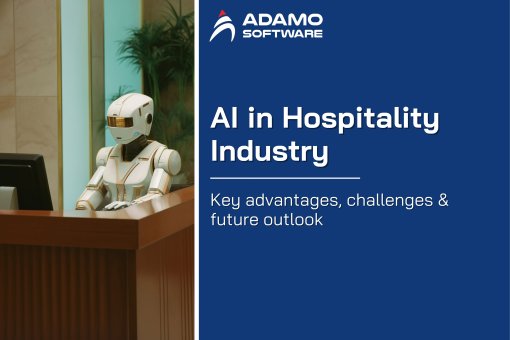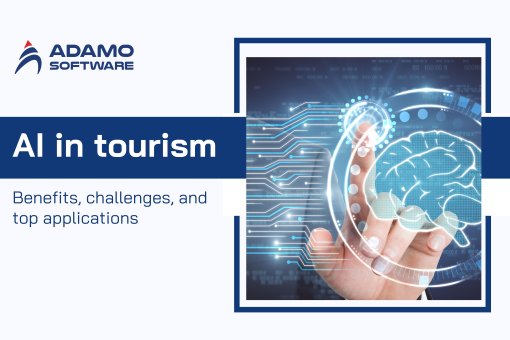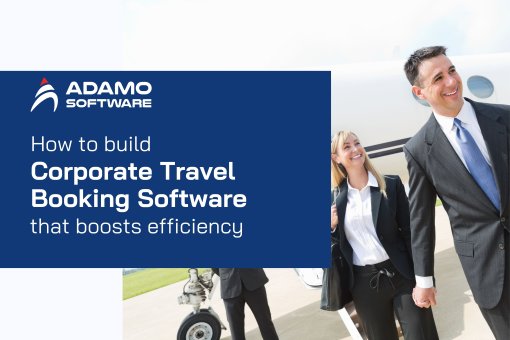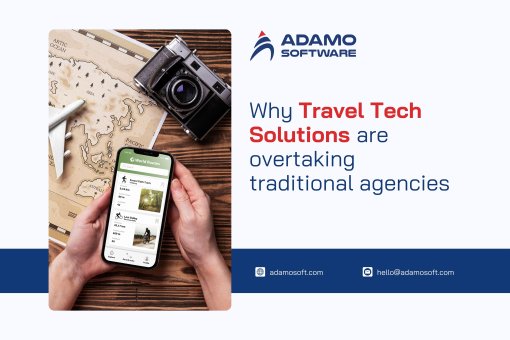Travel Software: 7 signs it’s time to upgrade and solutions
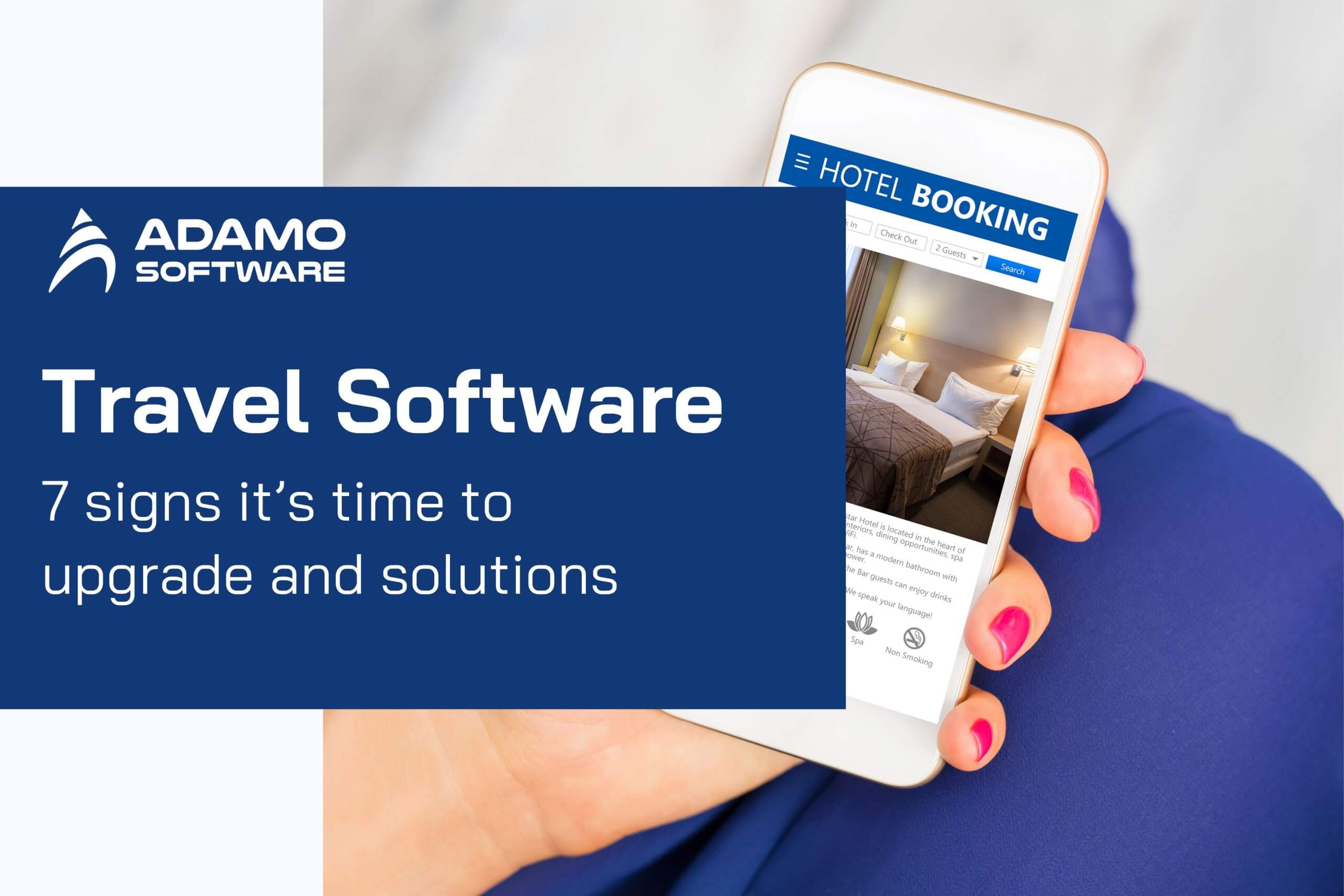
From inefficiency to missed opportunities – discover when to upgrade your travel software and unlock better solutions.
Travel software is critical to achieving efficient operations, customer satisfaction, and competitiveness. Nevertheless, the old systems may create inefficiency, low scalability, and customer dissatisfaction, restricting your business’s potential.
Upgrading isn’t just about fixing current issues – it’s also about planning ahead. Contemporary technologies make the work processes more organized, improved, and optimize customer experience. However, they are demanding to develop with proper planning and skills.
Therefore, outsourcing with a quality team will make the transition process smooth. Once properly guided, you can incorporate software that suits your needs, and your business will be sure of long-lasting success.
I. Why travel software needs regular upgrades
1. Adapting to Technological Advances
Maintaining updated travel software is crucial to remain relevant in a rapidly changing industry. The life span of the software is (usually) 3-5 years. Hence, travel agencies need to adjust it so that there is a balance between the stability of operations and the adoption of innovations. This ensures systems remain efficient while adapting to potential changes.
- Tighter security: Regular updates of sensitive guests and operational information against the emerging threats of cyberattacks. High encryption and improved authentication systems are the most popular features of updated systems.
- Heightened efficiency: Updated software boosts key processes, such as reservations, check-ins, and housekeeping. Research shows that simple improvements can increase efficiency by 15-30 percent, reducing operating bottlenecks.
- Future-ready tools: New-generation devices allow easy interface with emerging technologies like AI, mobile check-ins, and predictive analytics. Such flexibility will make your business thrive in the technology-informed market.
- Guest experience: More bookings, easier processes, and better guest experiences are possible due to an intuitive user interface. This includes personal features like use-based recommendations and loyalty, and reward programs.
2. Industry Insights on Software Upgrades
Regularly updating travel software also helps you to be aware of the latest industry insights on software updates. Specifically:
- Upgrade cycles: Hotels tend to review their software after 3-5 years to keep the systems consistent with the changing needs of the business and the industry.
- Efficiency: Efficiency could improve by up to 30% through specific upgrades. Streamlined service naturally boosts employee productivity.
- Downtime: Up-to-date systems can reduce downtimes by up to 40 percent, thus finding and reducing disruptions. This reduces downtime in the services provided to the guests and ensures uniformity in operations.
- High ROI: The rate of ROI on an upgrade of the travel software is usually 150 percent within five years. The alternative to being on top of anything is that it offers long-term advantages that exceed short-term expenses. This highlights the worth of contemporary culture.
II. 7 warning signs you need to upgrade your travel software
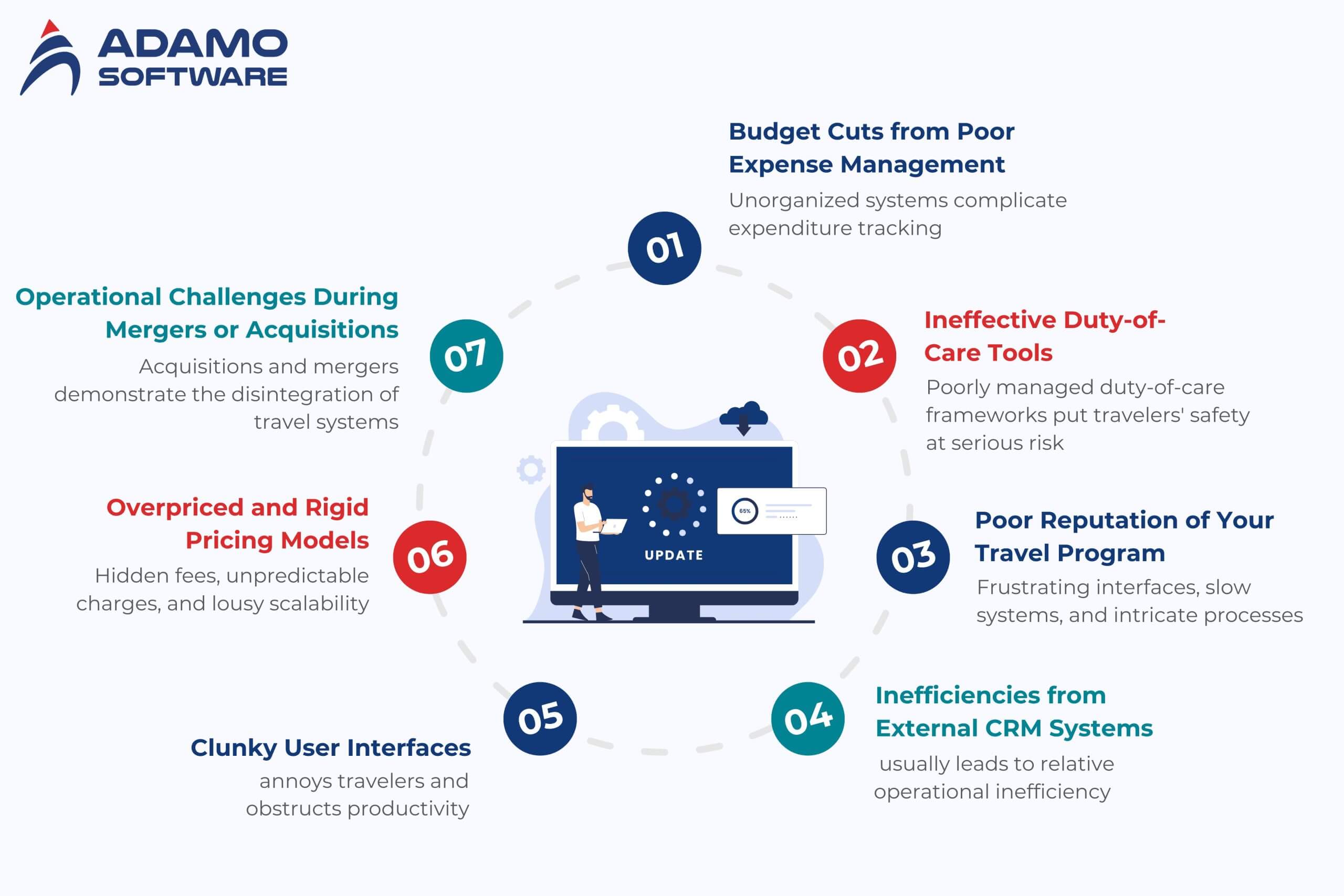
1. Budget Cuts from Poor Expense Management
One huge red flag is an uneven expense management process, showing that your travel software is not doing the trick. Unorganized systems complicate expenditure tracking, hence unauthorized payments and rogue expenditures occur.
When that happens, the finance departments are forced to reduce their budgets to exert control over them. Consequently, this could significantly impact your operations. Cutting the budget may lead to less traveling, fewer supplier deals, and fewer benefits to travelers.
Traditional reservation systems do not feature robust expense monitoring and reporting capabilities, so transparency and accountability are more challenging. With cost and efficiency tracking enhancement and increased visibility, modern travel software allows you to centralize your expenses and become more efficient. Such cost savings can be used to refurbish your company’s financial status, avoid further reductions, and streamline travel expenses.
2. Ineffective Duty-of-Care Tools
Poorly managed duty-of-care frameworks put travelers’ safety at serious risk. Travelers will have to be stuck in risky situations without efficient tools to provide real-time updates or safety alerts. A good example is that communication time could mean everything when there is a political crisis or a natural disaster.
Poor software is not only a threat to employee welfare, but it puts your firm at legal peril. Investing in upgraded travel software to help with duty-of-care options ensures you can meet your duty and ensure the safety of travelers. Seek out such functions as real-time monitoring, automatic notifications, and available, ready-to-use emergency resources. Through the appropriate software, you can reduce all risks, increase travelers’ confidence, and eliminate expensive legal problems.
3. Poor Reputation of Your Travel Program
The problem is that when your travel system is cumbersome or outdated, discontent sticks around like wildfire among employees. Frustrating interfaces, slow systems, and intricate processes may destroy morale, making attracting top talent more challenging. Negative reviews among the employees concerning your travel program will scare away high-performing candidates working in your company.
This trend can be reversed through an upgrade to modern travel software. Employee satisfaction can be significantly enhanced by offering intuitively ample booking tools, personalization options, and time-saving operations. Engagement surveys and feedback action will guarantee that your travel program is easy to use and responds to the employees’ needs.
When you have good experience in travel, you help motivate your employees in the workplace, and you become more appealing in the way you can attract and retain the type of talent you want to recruit.
4. Inefficiencies from External CRM Systems
Depending on other CRM solutions usually leads to relative operational inefficiency. Fragmentation of customer data, manual data entry, and synchronization errors also slow processes and expose them to more errors. They cause problems in delivering good customer service and may lead to a loss of opportunities to engage personally.
The latest travel software, equipped with built-in CRM features, addresses these concerns. Having all customer information on a single platform will allow you to reduce processing and keep it in sync.
Software integration also reduces the chances of data loss and ensures that all the information is up-to-date. This helps your team concentrate on establishing lasting customer relationships instead of handling fragmented systems.
5. Clunky User Interfaces
A complex user interface (UI) on your online booking tool (OBT) annoys travelers and obstructs productivity. Complex systems to use and poorly designed make in-channel bookings uneasy, and make travelers resort to consumer sites. This causes unauthorized journeys, low visibility in expenses, and challenges in monitoring the whereabouts of travelers, which can cause operational risks.
Recent travel software has an easy-to-use interface that makes booking easier. The absence of intuitive tools means that travelers no longer have to spend time searching for items. Now, anything can be easily found, lowering frustration rates and helping people adhere to company policy.
A new improved OBT will keep bookings in-channel so your team can better approve the trip, HP, and monitor their spending and safety requirements.
6. Overpriced and Rigid Pricing Models
One way is that the old reservation systems run the risk of pinching your pocket and stunting your growth due to their fixed pricing models. Hidden fees, unpredictable charges, and lousy scalability do not allow effective planning. Such restrictions tend to make businesses run in excess or provide services at a less-than-satisfactory level.
Updated travel programmers with clear and sizeable price models addresses these problems. Modern systems have greater financial predictability because you can fit your costs to your business’s requirements. Selecting software with a straightforward pricing structure enhances accuracy in budgeting so that resources are used efficiently.
7. Operational Challenges During Mergers or Acquisitions
Acquisitions and mergers demonstrate the disintegration of travel systems. For several travel management companies (TMCs) or incompatible platforms, the consolidation of operations is a logistical issue. Lack of policy integration, tracking the traveler, and reporting expenses may pose serious risks.
The upgrade of the travel software into a single platform would guarantee easier moves in times of organizational transformations. In centralized systems, operations are simplified, governance improves, and uniform reporting can be achieved.
The modern software also provides scalable integration, whereby you will manage a workforce that grows efficiently. By implementing your solution to fragmentation, you will minimize operational inefficiencies. This will prepare your travel program to fulfill its potential for the future.
III. Travel Software Upgrade Solutions: What are your options?
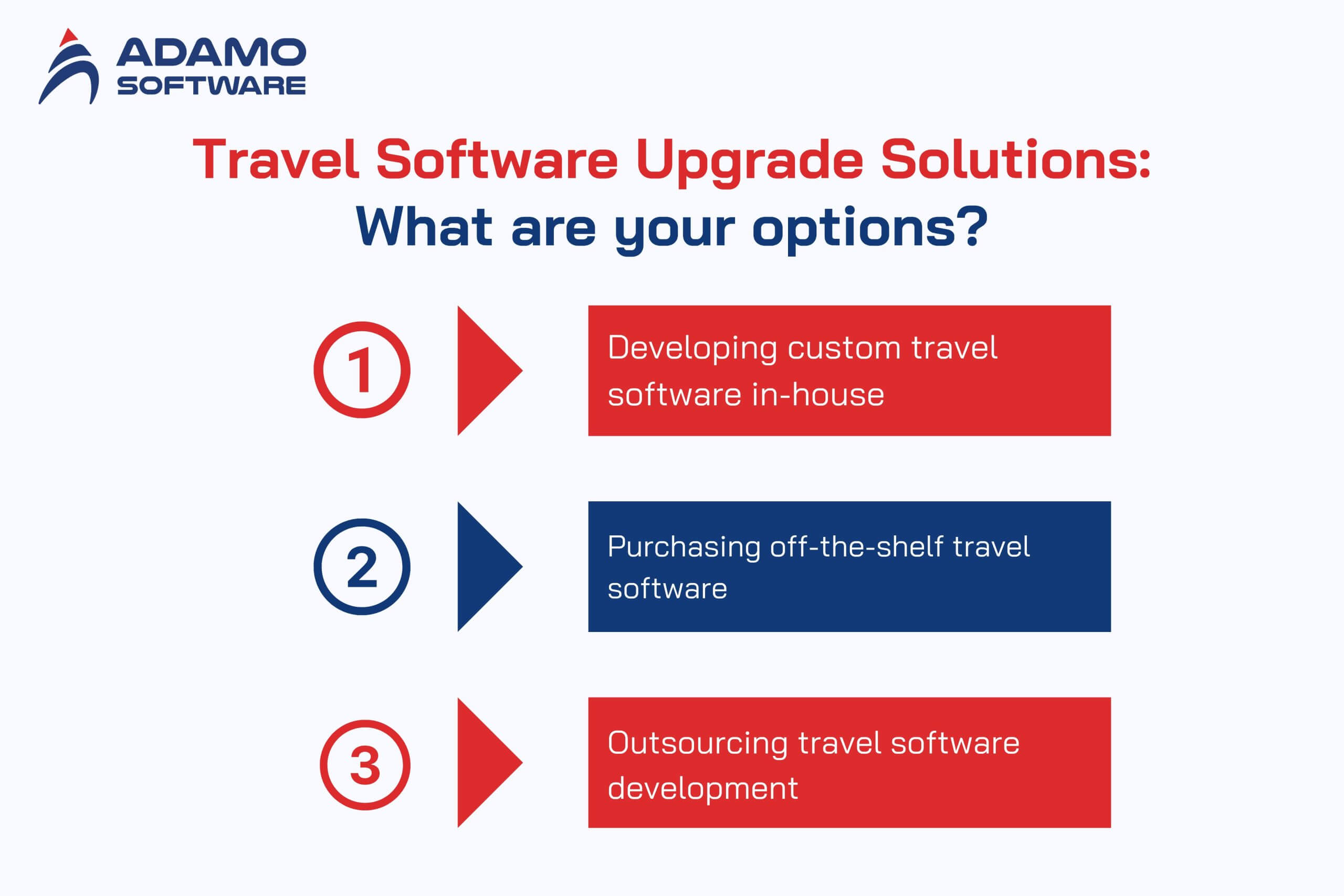
1. Developing Custom Travel Software In-House
The development of custom travel software by itself will provide complete freedom of functionality and integration. This alternative will enable you to create a service that suits your business. Being highly integrated with your internal systems can optimize you and make it very similar to what you have in place.
Nonetheless, this method will consume significant resources. The critical factors are high initial costs, a long development cycle, and the necessity to have it maintained by an experienced tech team. Also, the loss of senior developers may be disastrous because of the loss of knowledge, which would halt future updates.
This approach works best for companies at an enterprise level, where there is a well-established IT team and long-term infrastructure. Additionally, these companies should have a clear understanding of their software requirements in the long run. Firms that decide to take this route should be able to sustain the platform over time.
2. Purchasing Off-the-Shelf Travel Software
All-in-one travel software would be a suitable option for businesses needing accelerated implementation and lower initial expenditures. These ready-made systems meet common travel industry needs, making them ideal for small teams or startups with minimal customization requirements.
The main benefit is that it is cheap and fast. The platforms are readily deployable. Thus, a business does not have to wait before it can start addressing its immediate operational requirements.
They are, however, not flexible and elastic, which may turn out to be restrictive as your business expands. There is also the possibility of licensing limitations or restrictions on use that could be an issue for growing companies.
Off-the-shelf solutions suit businesses needing functionality but can hinder differentiation and future scaling. To succeed in the long term, companies should determine whether the platform can change as they change.
3. Outsourcing Travel Software Development
Outsourcing will compromise personalization and cost-effectiveness in the development of your travel software. With the partnership of a special development team, you will be able to find global talent with experience in travel technology. This is how you can develop custom solutions without spending resources on hiring an in-house workforce.
Outsourcing has several main advantages. The offshore destination cost can be reduced by up to 60 percent when dealing with Vietnam offshore. Agile delivery models provide a quicker time-to-market, and the scale of teams changes to meet the specific requirements of your project. As the technical workload is passed on to external teams, your internal personnel can work on strategy and growth.
Vietnam is now one of the desirable outsourcing travel app development locations. Booking engines, white-label portals, and other technology solutions are some platforms that companies such as Adamo Software have provided to global clients. The method is a blend of low prices, high-quality output, and the opportunity to be flexible. This way, it will be an appealing alternative to enhance the business travel software.
IV. What to Look for in an Outsourcing Partner
1. Commitment to Security and Compliance
Travel information is sensitive data, so the security and compliance of the outsourcing partner should be the priority. Compliance with GDPR, PCI-DSS, and the best practices in the data protection field, e.g., encryption and strong authentication, is mandatory.
By adhering to these standards, your partner will be able to preserve trust in the customers and integrity in business. Look at their certification and procedures that assure them of their capacity to safeguard your information. A secure platform will not only avoid breaches but also improve your image in the competitive travel industry.
2. Flexibility and Long-Term Support
A business partner through outsourcing must be flexible with the levels of support that are of interest to your business as it grows. Scaling development teams ensure seamless adaptability to varying needs. Additionally, maintaining your software after its deployment will enable it to work at its best.
Since travel businesses frequently grow, scalable solutions also represent an essential way of remaining atop the competition. Check whether the partner offers continuous updates, troubleshooting, and other services to be used over an extended period. An outfit willing to expand as you expand will future-proof your investment and guarantee ongoing value.
3. Expertise in Travel Industry Practices
A qualified travel industry partner can develop customized solutions for your business. Familiarity with GDS/API integration, loyalty schemes, and dynamic pricing is essential. An informed partner will also ensure your software is up to industry standards and can adapt to any unique challenges.
4. Strong Customization Capabilities
Custom software is more accurate than generic solutions as your business strives to reach its objectives. Find an operator who knows tech stack guidance, UX/UI design, and data security. Custom development is flexible, scalable, and has long-term value, enabling your business to change and remain competitive.
5. Agile Processes and Clear Communication
Agile techniques allow flexible changes, rapid delivery, and enhanced team cooperation. The frequent updates, demo calls, and such tools as Slack make communications transparent and avoid misunderstandings. When a partner is organized, your project is managed and aligned with your requirements.
6. Proven Track Record
There are successful travel software products from a reliable partner, such as OTA platforms or booking tools. Go through case studies and client references to cross-check their abilities. Their track record is what can characterize them in producing quality solutions that correspond to your goals.
V. Final thoughts
A travel software upgrade is the key to efficiency, scalability, and survival in the rapidly changing travel industry. It’s essential to handle fragmented expense systems, outdated interfaces, or obstacles to growth early on to be successful. Proactively addressing these challenges with a trusted outsourcing travel software development partner ensures a smooth transition and sets the stage for better outcomes.

Adamo Software ranks among Vietnam’s top development companies. We have provided more than 50 travel-related platforms and achieved 120+ projects cherished by 90% of our customers. Our skills range from custom, GDS connection, and scale travel services by demand.
Are you getting ready to future-proof your travel software? Contact Adamo to discuss how we can raise your business performance.






